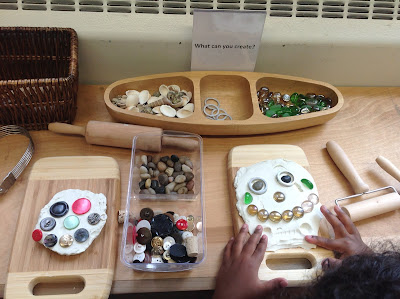Below are a few captured moments of our students engaging with the classroom materials. Since a few people have asked about where such materials can be found, Kathryn and I thought it might be a nice idea to show you a few of the art materials and loose parts that are used by our students and where they can be purchased.
A wonderful article on the loose parts theory as well as more information on the benefits of using loose parts, please take a look at Diane Kashin and Cindy Green's post:
Intentionality with loose parts: Playing, Tinkering and Messing About
A great start in familiarizing yourself with what and how loose parts can be used, as well as learning about different art mediums and techniques, I found these books to be great resources!
- that can be used in a variety of ways
- that have a variety of attributes and dimensions
- that promote creativity and problem solving because they allow children to decide how they will be used
- that can be enjoyed at many ages and stages of learning
- that will continue to be relevant, intriguing, and engaging over time
- that can be used with other materials to create more complex play opportunities
- that promote respectful, non-stereotyped, non-violent interactions among children
The Sunflower School Mystery of Materials Reggio Inspired Conference presentation by Brianne Bongiovanni
Rocks, stones (great to collect with your child or can purchase from Dollarama)
Wire (Dollarama, Home Hardware stores, Princess Auto, Michael's Craft store)
Shells (collect with your child, Dollarama, Micheal's Craft store)
Plasticine (Dollarama, Micheal's Craft store)
Wood sticks (Dollarama, Michael's Craft store)
Sketch Markers/Sharpies (Dollarama, Micheal's Craft store, Walmart)
Charcoal (Michael's Craft store, Walmart, DeSarres Art store)
Watercolour Paper (Micheal's Craft store, Walmart)
Watercolour paint crayons (Michael's Craft store)
Industrial tube packaging (Carpet stores, UPS, or Staples)
Laundry lids, cans (recyclable materials to save)
Red plastic jewels (floral shops)
Paint canvases of various sizes (Dollarama is cheapest)
Save corks, paper rolls, marker lids, and washers, screws
Thin wood and bark pieces (Creative Bags)
Save small cardboard boxes
Sticks, moss, pine needles (collect with your child outside)
Plastic petals, wood slices (Michael's Craft store,Creative Bags)
Buttons (save from old clothing, Dollarama, Micheal's Craft store, Walmart, thrift stores)
Colourful jewels (Dollarama is cheapest, Micheal's Craft store)
Poker chips (thrift stores, Dollarama)
Wooden Numbers (Micheal's Craft store)
Beads (Dollarama, Michael's Craft store, Walmart, thrift stores)
Wood Doweling (Home Hardware stores, Micheal's Craft store)
Sketch Book (Dollarama is cheapest, Michael's Craft store, Walmart)
Tempura Paint (Dollarama, Micheal's Craft store, Walmart)
Nice to purchase primary colours and have some fun colour mixing to create new colours!
Dominoes (Dollarama, Micheal's Craft store, Walmart, thrift stores)
Oil Pastels (Dollarama, Walmart, Michael's Craft store)
Crayola Watercolour Paint (We found this brand to be good quality, Walmart)
Yarn (Walmart, Michael's Craft store)
Great to create journey sticks or as we call them, Nature Pointers
Assorted tiles (Home Hardware stores, Restore, Michael's Craft store)
Coloured sand (floral shops)
Coloured Shells (Michael's Craft store)
Wooden beads (old necklaces from thrift stores, garage sales)
We would love to see some of your creations!
*****
Love this! S is VERY excited about stocking up on everything. Last night, while walking home from a friend's we spent the normally 4 minute walk, picking up leaves, branches, ferns, maple keys, and pinecones, to make a rocket ship out of. The kids spent a good half hour on the front porch, creating. Soon, out came the glue, markers, and (gulp) sparkly stickers, and the creations were made!
S's fire blaster ship was great! K's castle was super detailed, and both were so proud.
It was all S. He loves creating, and K has already learned so much from him. All thanks to you two!! Thanks again. You totally made my day.
*****
Hi Anamaria,
I thought you might like to see your teaching in action in the summer :) last night I printed the my plan and also photocopied the I wonder paper (C wrote this out for me). In the morning I told her to check her table and she was so happy with what she found.
Right away she grabbed a my plan and asked me if she could move some blocks and make a big construction area. She even let W help out and he got his name on the paper too.
She has also been sketching and writing in her log book.
Great to really see how much she loved the activities in your class. We really are lucky that she ended up with such a great teacher :)
*****
Hi Anamaria,
We had a birthday party today for C and her friends thought we should share with you what C made them for the loot bag. See attached..a butterfly with gummy bears.
And as gifts C chose to ask people to donate to the WWF specifically to help monarchs. All her friends seemed very happy to support this. Thanks for helping our kids to be aware of issues in the world!

























































